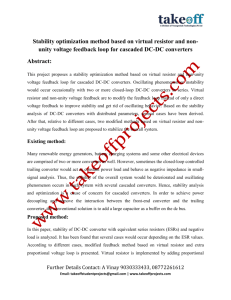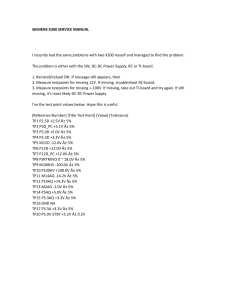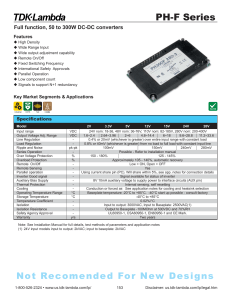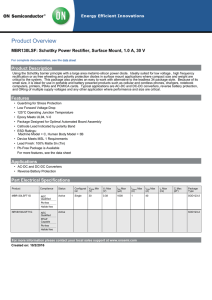Power Management Techniques for Energy Harvesting Embedded Systems
advertisement
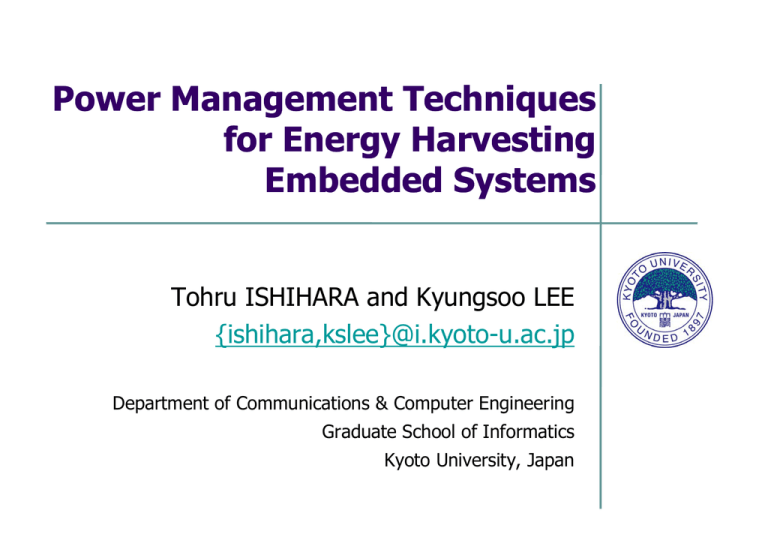
Power Management Techniques
for Energy Harvesting
Embedded Systems
Tohru ISHIHARA and Kyungsoo LEE
{ishihara,kslee}@i.kyoto-u.ac.jp
Department of Communications & Computer Engineering
Graduate School of Informatics
Kyoto University, Japan
My Talks in Previous MPSoC
Efficiency
Generating efficiency
Consuming efficiency
Harvesting device efficiency
Consumer device efficiency
Transferring efficiency
My talk at MPSoC 2009
“Multi-Performance Processor”
My talk at MPSoC 2011
“Scratchpad management”
My talk at MPSoC 2012
“Loop-cache management”
DC-DC converter efficiency
Charger efficiency
• Harvested energy is not constant
• Power is not available on-demand
• High peak power is not available
This talk
2
Energy Harvesting Devices
10 thermoelectric modules
generates microwatts
10m/s wind speed generates 100W
electrical power with 1m rotor diameter
800mW per shoe
at a pace of two
steps per second
1m/s water speed
generates 1W with
0.1m rotor diameter
3
Power Transferring Loss in
Portable System
Power breakdown in
portable audio player
Up to 15% of power is
dissipated in DC-DC
converters
15%
8%
10%
H. Shim, Y. Cho and N. Chang, "Power
Saving in Hand-held Multimedia Systems
Using MPEG-21 Digital Item Adaptation,"
in ESTIMedia, 2004
16%
25%
26%
CPU
LCD
M em ory
LCD Backlig ht
Fram e Buffer
DC-DC converter
4
Power consumption [W]
Power Transferring Loss in
Data Center
AC
input
Power transferring loss when
a computational load is 100W
VRs
208/120V
AC/DC DC/AC
AC/DC
DC/DC
CPU,
12Vdc
5.0V
DC/DC
UPS
PDU
PSU
Power Supply System
DC/DC
3.3V
Memory
etc.
DC/DC
Source: DC Power for Improved Data Center Efficiency, LBNL
5
Power Loss in Voltage
Conversion
Power loss depends on
input
DC-DC
output
Boost-up or drop-down
Voltage difference
Output power
Power Loss
(100 Efficiency ) Pinput
TPS63030 datasheet. http://www.ti.com/lit/ds/symlink/tps63030.pdf.
6
Motivations
Many
Different components use different voltages
Large
DC-DC converters are used in a system
power loss in the DC-DC converters
Voltage difference between source and load is large
Set the voltage here
Energy
source
DC-DC
DC-DC
DC-DC
Supply
voltage A
group
Supply
voltage B
group
Supply
voltage C
group
e.g.) CPU
1.0V
e.g.) modem e.g.) camera
3.3V
5.0V
7
Reconfigurable Array
An example for a configurable array
3 configurations with 4 photovoltaic
(PV) cells or super-capacitor cells
Each cell has 0.5V, 80mA output
Reduce the difference
between the input and
output voltages in a
DC-DC converter
(4,1): 0.5V, 320mA output
(2,2): 1V, 160mA output
(1,4): 2V, 80mA output
M. Uno, “Series-parallel reconfiguration technique for supercapacitor energy
storage systems,” in Proc. of TENCON, 2009.
Y. Kim, et al. “Balanced Reconfiguration of Storage Banks in a Hybrid Electrical
Energy Storage System,” in Proc. of ICCAD, pp.624-631, November 2011.
8
Proposed System Architecture
System block diagram
Good harvest mode
Hybrid mode
Bad harvest mode
Power OR’ing by Linear
Technology’s ideal diode
9
Good Harvest Mode
Enough sunlight to operate the loads
Control the configuration
to minimize the total loss
10
Hybrid Mode
Not enough sunlight to operate the loads
Control the configuration
to minimize the total loss
11
Bad Harvest Mode
The power loss in the Conv_cap is more than the
amount of generated power from the PV array
Control the configuration
to minimize the total loss
12
One Case Result for the Array
Configuration
Power loss in converters for different configurations
• CPU, modem, and
camera consume
100mA, 30mA, and
1mA respectively
• Sunlight intensity and
state of charge in
super-cap are 100%
and 20% respectively
The lowest
power loss
configuration
13
Scheduling
I/O aware task scheduling
Minimize the overlap among CPU tasks and I/O tasks
Make the chance of power reduction larger
K. Lee, T. Ishihara, “I/O Aware Task Scheduling for Energy Harvesting Embedded
Systems with PV and Capacitor Arrays,” in Proc. of IEEE Symposium on Embedded
14
Systems for Real-Time Multimedia (ESTIMedia 2012), pp. 48-55, October, 2012
Experimental Results
72% reduction in conversion loss
25% reduction in total power
Conventional
120
Proposal
loss_conv
loss_char
loss_p
loss_mod
loss_cam
proc.
mod.
cam.
100
80
60
40
20
0
80
20
100
80
20
60
Sunlight intensity
80
20
20
State of Charge
of super-capacitor
15
Conclusion
Dynamic selection of three power path configurations
Simultaneous array configuration and task scheduling
Energy efficiency in each harvesting condition can be maximized
Multiple supply voltage loads are considered
Power loss in DC-DC converters can be reduced by 72%
Contribution
System cost efficiency and quality of services can be improved
without oversizing a PV array or an energy storage
16

